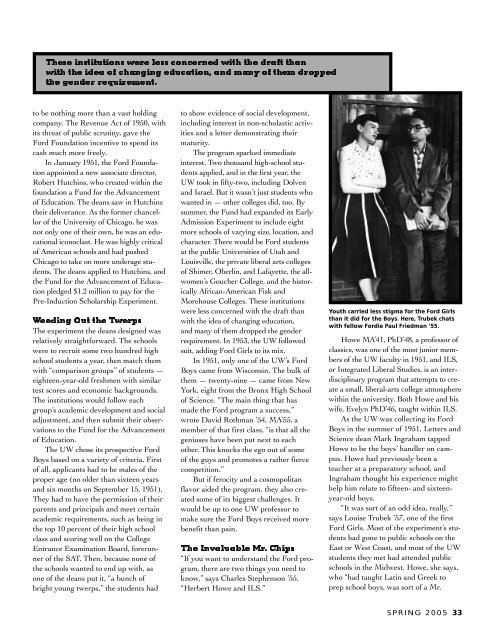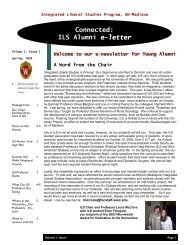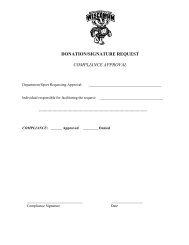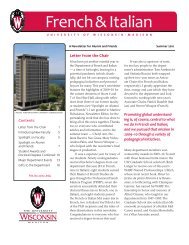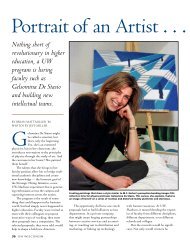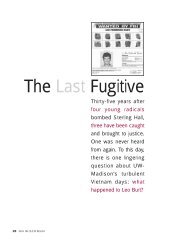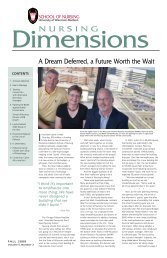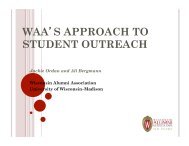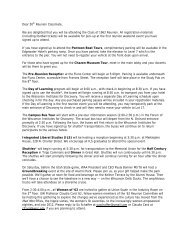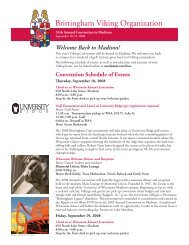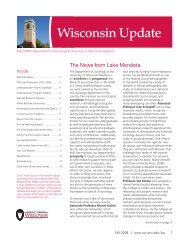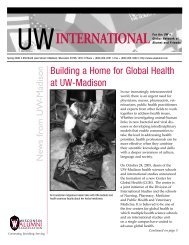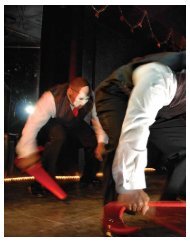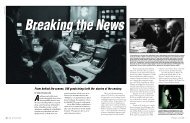The Ford Boys (pdf) - Wisconsin Alumni Association
The Ford Boys (pdf) - Wisconsin Alumni Association
The Ford Boys (pdf) - Wisconsin Alumni Association
- No tags were found...
Create successful ePaper yourself
Turn your PDF publications into a flip-book with our unique Google optimized e-Paper software.
<strong>The</strong>se institutions were less concerned with the draft than<br />
with the idea of changing education, and many of them dropped<br />
the gender requirement.<br />
to be nothing more than a vast holding<br />
company. <strong>The</strong> Revenue Act of 1950, with<br />
its threat of public scrutiny, gave the<br />
<strong>Ford</strong> Foundation incentive to spend its<br />
cash much more freely.<br />
In January 1951, the <strong>Ford</strong> Foundation<br />
appointed a new associate director,<br />
Robert Hutchins, who created within the<br />
foundation a Fund for the Advancement<br />
of Education. <strong>The</strong> deans saw in Hutchins<br />
their deliverance. As the former chancellor<br />
of the University of Chicago, he was<br />
not only one of their own, he was an educational<br />
iconoclast. He was highly critical<br />
of American schools and had pushed<br />
Chicago to take on more underage students.<br />
<strong>The</strong> deans applied to Hutchins, and<br />
the Fund for the Advancement of Education<br />
pledged $1.2 million to pay for the<br />
Pre-Induction Scholarship Experiment.<br />
Weeding Out the Twerps<br />
<strong>The</strong> experiment the deans designed was<br />
relatively straightforward. <strong>The</strong> schools<br />
were to recruit some two hundred high<br />
school students a year, then match them<br />
with “comparison groups” of students —<br />
eighteen-year-old freshmen with similar<br />
test scores and economic backgrounds.<br />
<strong>The</strong> institutions would follow each<br />
group’s academic development and social<br />
adjustment, and then submit their observations<br />
to the Fund for the Advancement<br />
of Education.<br />
<strong>The</strong> UW chose its prospective <strong>Ford</strong><br />
<strong>Boys</strong> based on a variety of criteria. First<br />
of all, applicants had to be males of the<br />
proper age (no older than sixteen years<br />
and six months on September 15, 1951).<br />
<strong>The</strong>y had to have the permission of their<br />
parents and principals and meet certain<br />
academic requirements, such as being in<br />
the top 10 percent of their high school<br />
class and scoring well on the College<br />
Entrance Examination Board, forerunner<br />
of the SAT. <strong>The</strong>n, because none of<br />
the schools wanted to end up with, as<br />
one of the deans put it, “a bunch of<br />
bright young twerps,” the students had<br />
to show evidence of social development,<br />
including interest in non-scholastic activities<br />
and a letter demonstrating their<br />
maturity.<br />
<strong>The</strong> program sparked immediate<br />
interest. Two thousand high-school students<br />
applied, and in the first year, the<br />
UW took in fifty-two, including Dolven<br />
and Israel. But it wasn’t just students who<br />
wanted in — other colleges did, too. By<br />
summer, the Fund had expanded its Early<br />
Admission Experiment to include eight<br />
more schools of varying size, location, and<br />
character. <strong>The</strong>re would be <strong>Ford</strong> students<br />
at the public Universities of Utah and<br />
Louisville, the private liberal arts colleges<br />
of Shimer, Oberlin, and Lafayette, the allwomen’s<br />
Goucher College, and the historically<br />
African-American Fisk and<br />
Morehouse Colleges. <strong>The</strong>se institutions<br />
were less concerned with the draft than<br />
with the idea of changing education,<br />
and many of them dropped the gender<br />
requirement. In 1953, the UW followed<br />
suit, adding <strong>Ford</strong> Girls to its mix.<br />
In 1951, only one of the UW’s <strong>Ford</strong><br />
<strong>Boys</strong> came from <strong>Wisconsin</strong>. <strong>The</strong> bulk of<br />
them — twenty-nine — came from New<br />
York, eight from the Bronx High School<br />
of Science. “<strong>The</strong> main thing that has<br />
made the <strong>Ford</strong> program a success,”<br />
wrote David Rothman ’54, MA’55, a<br />
member of that first class, “is that all the<br />
geniuses have been put next to each<br />
other. This knocks the ego out of some<br />
of the guys and promotes a rather fierce<br />
competition.”<br />
But if ferocity and a cosmopolitan<br />
flavor aided the program, they also created<br />
some of its biggest challenges. It<br />
would be up to one UW professor to<br />
make sure the <strong>Ford</strong> <strong>Boys</strong> received more<br />
benefit than pain.<br />
<strong>The</strong> Invaluable Mr. Chips<br />
“If you want to understand the <strong>Ford</strong> program,<br />
there are two things you need to<br />
know,” says Charles Stephenson ’55.<br />
“Herbert Howe and ILS.”<br />
Youth carried less stigma for the <strong>Ford</strong> Girls<br />
than it did for the <strong>Boys</strong>. Here, Trubek chats<br />
with fellow <strong>Ford</strong>ie Paul Friedman ’55.<br />
Howe MA’41, PhD’48, a professor of<br />
classics, was one of the most junior members<br />
of the UW faculty in 1951, and ILS,<br />
or Integrated Liberal Studies, is an interdisciplinary<br />
program that attempts to create<br />
a small, liberal-arts college atmosphere<br />
within the university. Both Howe and his<br />
wife, Evelyn PhD’46, taught within ILS.<br />
As the UW was collecting its <strong>Ford</strong><br />
<strong>Boys</strong> in the summer of 1951, Letters and<br />
Science dean Mark Ingraham tapped<br />
Howe to be the boys’ handler on campus.<br />
Howe had previously been a<br />
teacher at a preparatory school, and<br />
Ingraham thought his experience might<br />
help him relate to fifteen- and sixteenyear-old<br />
boys.<br />
“It was sort of an odd idea, really,”<br />
says Louise Trubek ’57, one of the first<br />
<strong>Ford</strong> Girls. Most of the experiment’s students<br />
had gone to public schools on the<br />
East or West Coast, and most of the UW<br />
students they met had attended public<br />
schools in the Midwest. Howe, she says,<br />
who “had taught Latin and Greek to<br />
prep school boys, was sort of a Mr.<br />
SPRING 2005 33


